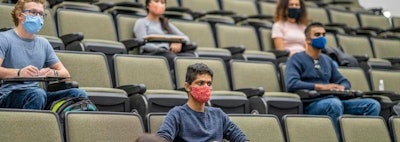In the second year of the pandemic, transfer enrollment continued its decline, albeit at a slower rate, according to a new report from the National Student Clearinghouse Research Center (NSCRC).
The report, which was based on data from schools attended by over 13 million undergraduates, found that 296,200 fewer students transferred during the pandemic, a 13.5% decrease. Nearly 2/3 of that loss occurred in year one of the pandemic (2020-21), with the remaining third coming in year two (2021-22). Transfer enrollment declined more than twice as steeply as overall enrollment, suggesting that the dip is not simply because fewer students have started college during the pandemic.
“Transferring during a pandemic is hard,” said Dr. Doug Shapiro, executive director of the NSCRC, in a press briefing. “Imagine navigating two sets of shifting pandemic policies on top of all the transfer policies, without the benefit of in-person advisors or other campus-based support networks.”
All transfer pathways experienced declines, but transfers into two-year institutions were particularly affected. Lateral transfers (two-year to two-year) declined by over 21% and reverse transfers (four-year to two-year) declined by 18%.
“In normal times we consider these pathways to be important backstops to students at risk of dropping out,” said Shapiro. “They enable students to change institutions as their needs and aspirations change. Students who feel trapped in programs that no longer meet their needs are more likely to stop out or drop out altogether. So, these declines are really a problem for all of higher education.”
However, the second year of the pandemic brought a shift in the decline. In year one, the most affected pathway was reverse transfer, but in the second year, the most affected pathway was upward transfer (from two-year to four-year schools).
According to Shapiro, this shift has dual causes.
“We’d had a whole year of declined enrollment at community colleges, and there were simply fewer students available to transfer,” he said. “At the same time, it suggests that students were questioning their plans of attaining a four-year degree in the first place. I think a lot of that had to do with perceptions of rising costs, perceptions of increased burdens of student debt, and a stronger labor market, even for unskilled workers.”
These conditions may have led to a large drop in transfers by students 21 and older. Older learners declined at more than twice the rate of younger students and represented over 85% of the overall pandemic decline in transfer students. The rates of decline were similar for white students (16.4%), Black students (16.4%), Native American students 15.6%) and Latinx students (12.2%), which Shapiro called “surprising” in a panel discussion of the report.
“It’s clear that we’re not just seeing some kind of systemic racial inequities across the board in the pandemic’s effect,” said Shapiro.
Schools that serve specific populations were affected differently, the report showed. Transfers to Hispanic Serving Institutions dropped almost 17% during the pandemic, but transfers to HBCUs dropped only 4.2%.
“Layering the pandemic in with very serious concerns about racial inequities, and after the murder of George Floyd, I suspect that black [students] are seeking institutions where there's a strong sense of belonging and safety. And I do think that HBCUs in particular have those things present,” said Dr. Janet Marling, executive director of the National Institute for the Study of Transfer Students at the University of North Georgia.
However, even when students did successfully transfer, they were less likely to remain in school than before the pandemic. The persistence rate—the percentage of students who were still attending school a term after transferring—dropped in every category. Latinx and Native American students experienced declines nearly twice that of any other racial or ethnic group.
“It’s particularly troubling,” said Shapiro. “You would think that those who had managed to transfer in times like this would have to be among the most determined and persistent students around.”
The second year of the pandemic did see persistence rebounds for every category of institution except for community colleges. The persistence of students aged 20 and younger returned to its pre-pandemic level, and men made gains, although women declined, a reversal of the first-year trend.
But despite these improvements, colleges will need to do a lot to limit the damage of the pandemic.
“Today’s missing transfer students will too often become tomorrow’s missing graduates unless educators and policy makers respond quickly with interventions tailored to the needs of affected learners,” said Shapiro.
Marling agreed.
“Overcoming these declines will require a long-term commitment,” she said. “Two things that we know that transfers need more than anything are money and momentum. What that translates into is financial support and ensuring that as many of their credits apply as possible.”
Without this support, said Marling, the consequences could be serious.
“It sets us up for concern down the line related to being able to meet our workforce needs,” said Marling, “and ensuring that diverse populations have economic mobility moving forward.”


















